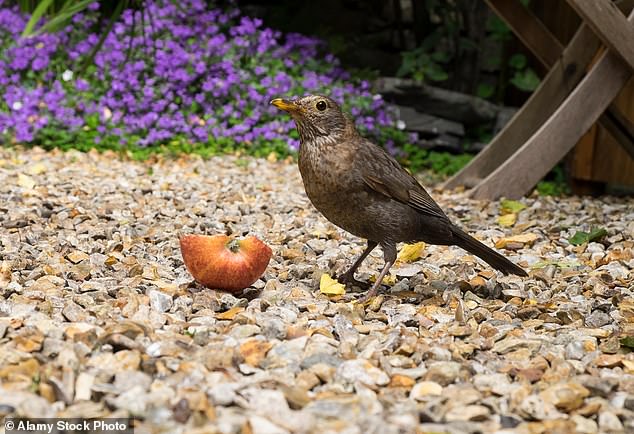FEEDING OUR FEATHER FRIENDS
In winter, wild birds need a high-fat diet.
We can help encourage their entry into our gardens by placing suet blocks in wire cages or make our own by melting suet in coconut half shells and hanging them from trees. Do not use plastic nets, as some birds can get their beaks trapped in them.
Place finely chopped bacon rind and grated cheese for small birds such as wrens.
If you have overripe apples, cut them up and scatter them on the ground with some raisins for ground-feeding songbirds such as blackbirds and thrushes. It is also a good idea to take out seeds and nuts for a balanced diet.
If you are using a table or hanging bird feeder, be sure to keep it clean to prevent the spread of avian diseases. Do the same when providing water to birds.
The best foods are seeds and berries growing in the garden, so be sure to include plenty of these and don’t prune them too early in winter.
Instead of being too tidy, leave blackened sunflower heads for birds to feed on, as well as rose hips and wilted grapes on the vine.
Gardening expert Ciar Byrne advises giving wild birds (pictured) in the garden a high-fat diet in winter.
WINTER VEGETABLE HARVEST
December can be a month of abundance in the garden. There are still carrots, celeriacs, parsnips, turnips and winter radishes in the ground, which should be dug up now.
Brussels sprouts are at their best. Pick individual sprouts as needed, starting at the bottom, or cut off the entire stem and place the end in a bucket of cold water until you are ready to use it.

In December, there are still carrots (pictured), celeriac, parsnips, turnips and winter radishes in the ground, which should be dug up now.
PERFECT SWEET PEAS
If you planted sweet peas in late fall, they should soon be ready to be plucked. Do this when the seedling reaches about 10cm in height to encourage bushier growth. Pinch the tip with your fingernails.
Sweet pea seeds need a temperature of about 15°C to germinate, but once they are growing, move them to a cool, frost-free environment, such as an unheated greenhouse.

If you planted sweet peas (pictured) in late fall, they should soon be ready to be plucked.
PLANT OF THE WEEK
ILEX AQUIFOLIUM ‘SILVER QUEEN’
Contrary to its name, this award-winning variegated holly is a male plant, so it does not produce berries.
It is still worth growing for its beautiful glossy dark green leaves with creamy white margins.
In late spring it produces clusters of small white flowers that are ideal for bees and other insects, and is a good pollinator for nearby female hollies.
It is slow growing and takes between 20 and 50 years to reach its full size, which can reach up to 4 m wide and 8 m high.

Ilex aquifolium ‘silver queen’ (pictured) has beautiful glossy dark green leaves edged with creamy white

Rake the lawn and remove any moss and turn it into a compost pile.
READER QUESTION
What should I do about moss on my lawn?
Gary Baker, Oldham.
You don’t necessarily have to do anything. We’re learning to embrace moss on lawns as part of a biodiverse habitat for beetles, scale insects, and other mini-beasts; In addition, birds use it to line their nests. The Japanese embrace moss in their gardens.
If you really want to get rid of it, try scarifying the lawn with a rake and removing the moss and placing it in a compost pile, or use it on top of a container of spring bulbs or in a hanging basket.
Moss tends to grow in the shade, so cut back any overhanging branches and use a shade-tolerant grass mix.

